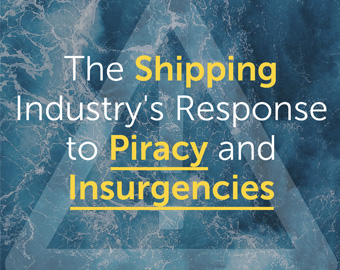Improving cost efficiency in sea freight : The hardware
04 December 2015
An interview with Terry Churchill, General Manager
 Plan ahead, avoid peak shipping periods if you can and, above all, speak to the experts. That’s the advice from Terry Churchill, who says shippers can make huge savings on freight costs, whether we are talking about consumer goods in containers from China or huge one-off out-of-gauge (OOG) project cargo shipments.
Plan ahead, avoid peak shipping periods if you can and, above all, speak to the experts. That’s the advice from Terry Churchill, who says shippers can make huge savings on freight costs, whether we are talking about consumer goods in containers from China or huge one-off out-of-gauge (OOG) project cargo shipments.
“The thing that doesn’t get considered very often is planning the timing of your shipping – there are peak times where slots are restricted and rates are higher and, if you don’t need to ship in those periods, why would you do it?” he says. “Often people just ship goods because the goods are ready. But if I didn’t have to, I wouldn’t choose to ship in the October/November pre-Christmas rush.
“From a buyer’s perspective, he says: “If you can project volumes, you can negotiate better rates with forwarders and shipping lines. You should be looking for planned distribution as opposed to ad hoc shipments. The more lead time you have, the better shopping around you can do and the better rates you can access.”
This principle is probably even more critical when it comes to shipping heavy lift and project cargo – a massive generator or turbine, for example. “You can save vast amounts of money if you plan how you are going to transport the item before it is even built,” says Terry. “Get the forwarder involved so they can advise the best way of doing it. Transport options should be discussed at the very beginning, before the item is built or even designed.”
Expert packers and forwarders often lament customers’ failure to consult them early in such a project – a failure which can cost the customers dearly. “We don’t want to be telling the shipper – ‘if you had told us that, we would have done it very differently’,” says Terry. “Part of your internal planning should be to appoint your forwarder as early as possible, especially in projects, so you proactively design and plan between you – as opposed to ‘you need to come and pick this up now’.
“Our team have the expertise and skill sets to design and create the most efficient method of shipping, taking into account the handling equipment, load planning, etc.”
“Working with the customer from the start will enhance our efficiencies. We can assess how a major item is to be loaded – for example, can things be loaded on their side? We can help design what the goods will look like when they are moved and advise the customer the best way to construct their freight from the cost and loading perspective. For example, a large item in one single piece might cost $100,000 to ship but if it can be shipped in two pieces to be assembled at the end destination, the cost might be only $60,000.”
Of course, Terry says, there are instances where last-minute shipping can’t be helped and Allseas will always seek the most effective price. “But the more time you have to look at it and work it out, the better. If it’s a case of ‘I need a price by 5pm’, then we don’t have much time to make calls and see if there’s a better deal out there. And of course, if a shipper gets close to the deal and ends up doing the transport by air, then that is very expensive.”
For example, moving a loaded container from China to Europe by sea would cost around $1,000. The same container moved by air would cost closer to $50,000.
There is the option to get vessels planned and bookings made early and cancel if necessary nearer the date – if it’s a container, that’s not the end of the world. However, if the booking involved a whole block of containers or a massive OOG piece, clearly the lines would not be happy.
And in any case, says Terry: “If you keep booking and then cancelling with the lines, you lose credibility as a forwarder. The lines would soon note that you had a habit of cancelling; they would no longer pull out all the stops and give the lowest rates. And then everyone loses.”
So what might be on offer? Allseas would normally offer a choice of solutions – for example, rates for a direct sailing in a few days’ time, or for a direct sailing ten days later which might be a little cheaper, and/or for a route that involved transhipment, perhaps adding another seven days overall but reducing the costs significantly.
“It is really a case of balancing out the cost and the transit time,” says Terry. “If you play a longer game and far enough ahead, you can take advantage of a slower transit and cheaper rate. But if you are time-short, the time is the driver and price is secondary.”
Once you have confirmed your slot for that all important container, there’s another important factor to consider – using all of the space you have paid for. Far too often, shippers load containers inefficiently, failing to make the best use of the capacity.
“It is effectively your shipment – make the most of it! Don’t be in a position where you need another container in three weeks’ time for items you could have shipped in the earlier container. Design boxes so they fit efficiently inside the container, top to bottom, excluding pallets. After all, two feet across the top, across the length of the container, is a lot of space and you are effectively paying to move fresh air. Again, it’s all down to planning.”
And finally, there is the environment. Reducing packaging, eliminating wastage, making full use of the container’s capacity – these will all reduce your carbon footprint, as well as saving money. “If you send your goods in two containers instead of five containers because you have used the space properly, that will make a huge difference. Don’t forget, it’s not just about the shipping leg – there is also the road haulage or rail transport around the country to consider, and the carbon footprint across the whole transportation chain. Shipping is the most environmentally friendly method of freight transport. Make the most of it!”
Sign up to our newsletter
To receive bi-monthly industry updates, plus opinion and insights from our expert Logistics Consultants, sign up here.
This site is protected by reCAPTCHA and the Google
Privacy Policy and Terms of Service apply.


